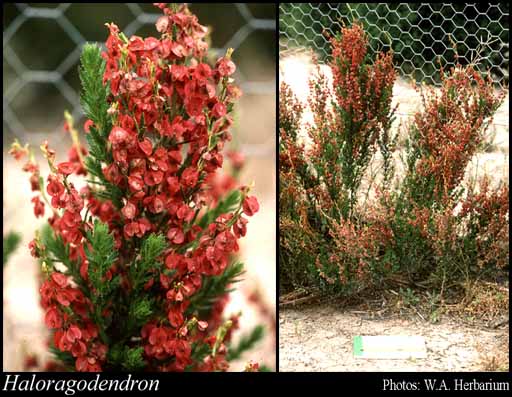- Reference
- Bull.Auckland Inst.Mus. 10:140 (1975)
- Name Status
- Current

Scientific Description
Common name. Raspworts. Family Haloragaceae.
Habit and leaf form. Small trees, or ‘arborescent’, or shrubs. Young stems tetragonal. Stem growth not conspicuously sympodial (monopodial). Hydrophytic to helophytic, or mesophytic; the aquatics rooted. Leaves opposite; decussate; petiolate, or sessile; simple; epulvinate. Leaf blades entire (juvenile leaves pinnatisect or pinnatifid); oblong, or ovate, or obovate, or linear; one-veined, or pinnately veined. Leaves without stipules. Leaf blade margins serrate. Leaf anatomy. Hairs absent.
Reproductive type, pollination. Fertile flowers hermaphrodite. Unisexual flowers absent. Plants hermaphrodite. Anemophilous.
Inflorescence and flower features. Flowers aggregated in ‘inflorescences’; in cymes. The terminal inflorescence unit cymose. Inflorescences terminal; inflorescences of simple or compound dichasia in an elongated spike, lateral inflorescences in upper axils; pseudanthial, or not pseudanthial. Flowers pedicellate, or sessile; bracteate (bracts decussate, leaf-like); bracteolate (bracteoles thin, membranous). Bracteoles deciduous. Flowers minute to small; regular; (2–)4 merous; cyclic; tetracyclic, or pentacyclic. Free hypanthium absent. Perianth with distinct calyx and corolla; 8; 2 -whorled; isomerous; free. Calyx present; 4; 1 -whorled; polysepalous; valvate; exceeded by the corolla; regular; persistent. Sepals ovate, or triangular. Corolla present; 4; 1 -whorled; polypetalous; regular; green, or white, or cream, or red. Petals not hooded; navicular. Androecial members definite in number. Androecium 8. Androecial members free of the perianth; all equal; free of one another; 2 -whorled. Androecium exclusively of fertile stamens. Stamens 8; all more or less similar in shape; diplostemonous; alternisepalous and oppositisepalous; filantherous (with rather large anthers). Anthers basifixed; non-versatile; dehiscing via longitudinal slits; latrorse; four locular; tetrasporangiate; appendaged (apiculate); apiculate. Gynoecium (2–)3–4 carpelled. The pistil 4 celled. Gynoecium syncarpous; synovarious; inferior. Ovary plurilocular; 4 locular. Epigynous disk absent. Gynoecium stylate. Styles 4; free; apical. Placentation apical. Ovules 1 per locule; pendulous; anatropous.
Fruit and seed features. Fruit non-fleshy. Pericarp woody with solid septa. Fruit indehiscent; a nut; 4 locular; 1 seeded. Seeds more or less copiously endospermic. Endosperm oily. Cotyledons 2. Embryo straight.
Special features. Inflorescence determinate.
Etymology. From genus Haloragis and the Greek for "tree", referring to the shrubby or small tree habit of the species included.